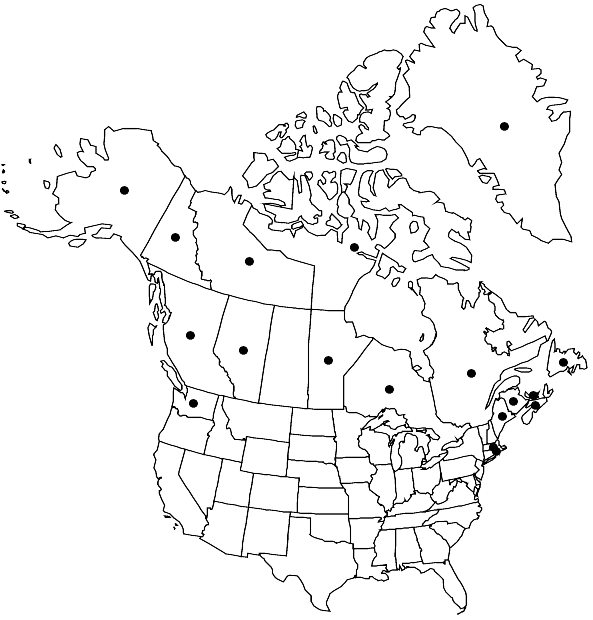Dicranum majus var. majus
Plants in loose tufts, green to light green, glossy. Leaves falcate-secund, flexuose, 8–11.5 (–15) mm; margins serrate in distal half; costa percurrent to shortly excurrent, toothed distally on abaxial surface, with a double row of guide cells.
Phenology: Capsules mature spring.
Habitat: Humus, soil, soil over rock, and rotten wood in coniferous woods, bogs, and tundra
Elevation: 0-1500 m
Distribution

Greenland, Alta., B.C., Man., N.B., Nfld. and Labr. (Nfld.), N.W.T., N.S., Nunavut, Ont., P.E.I., Que., Yukon, Alaska, Maine, Mass., R.I., Wash., Europe, Asia
Discussion
Variety majus is known by its glossy, long (8–15 mm), falcate-secund leaves with serrate margins in the distal half, by its costae with two rows of guide cells (seen in cross section), the abaxial surface toothed and not ridged distally, and by its aggregate setae (2–5 per perichaetium).
Selected References
None.
Lower Taxa
None.
... more about "Dicranum majus var. majus"
undifferentiated +
differentiated +
differentiated +
hyaline +
ridged +
short to long +
short to long +
compound +
absent +
differentiated +
tubulose +
falcate-secund +
straight +
8mm;11.5mm +
long +
concave;acute;narrowed;ovatelanceolate;lanceolate +
hyaline +
short to long +
absent +
differentiated +
tubulose +
not bulging +
microphyllous +
deciduous +
absent +
asexual +
absent +
absent +
naked +
fugacious +
covering +
cucullate +
furrowed +
arcuate +
exserted +
wrinkled +
cylindric +
specialized +
projecting +
distal +
few +
inflated +
percurrent;shortly excurrent +
strong +
toothed +
toothed +
47um;61um +
pitted +
10um;11um +
falcate-secund +
straight +
papillose +
convolute-sheathing +
long-acuminate +
enlarged +
secund +
falcate-secund +
hyaline +
ridged +
short to long +
sparse +
flexuose +
erect-patent +
interior +
serrate +
incurved +
plane +
entire to serrate +
involute +
long-rostrate +
convolute-sheathing +
subulate +
pitted-striolate +
divided +
female +
undifferentiated +
differentiated +
elongate +
concave +
Muscol. Hibern. Spic., +
2-stratose +
whitish +
arising +
serrated +
interrupted +
scattered +
well-developed +
aggregate +
yellow;light-brown +
erect +
elongate +
spherical +
with a few whitish rhizoids;naked +
erect +
absent +
tomentose +
epiphytic +
forked +
superficial +
absent +
Dicranum majus var. majus +
Dicranum majus +
variety +
deciduous +
lanceolate +
dense +
thickened +
glossy +
small;large +